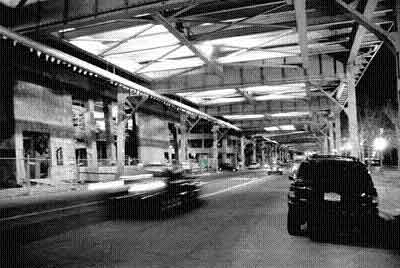| District is Trying to Topple the Whitehurst Fwy | ||||||||||||||||
|
There are two sides to the Whitehurst Freeway: The one above, where drivers catch a sweeping view of the Potomac as they swing around Georgetown on the elevated bypass. And the one below, a darkened, grimy underbelly of urban highway, filled with exhaust and the constant clack-clack of the cars rumbling overhead.
It is the latter view that is propelling D.C. officials to move forward with plans to tear down the structure. They say the freeway divides Georgetown and casts a dark shadow, literally, on a slice of waterfront that is fast turning into a chic hot spot. Washington officials considered [taking down] the Whitehurst a decade ago before community and construction concerns caused them to instead spend $35 million to rebuild the freeway. Nonetheless, the idea is back under consideration. The Whitehurst was built in 1949 to link the Key Bridge to a citywide freeway system that was never completed. In those days, the Georgetown waterfront was not the hip destination it is today; it had a lumberyard, cement works and a meat rendering plant.
|
The waterfront has changed considerably, even since 1998, when the city finished rebuilding the freeway....Property values have more than doubled in the past seven years. The Whitehurst, some say, is all that stands in the way of creating a premier spot. But drivers see the Whitehurst, which connects to Key Bridge and Canal Road on its western end and 27th Street to the east, as a way around Georgetown. The plans to take down the freeway hinge on whether there's a way to give those people another route downtown.
District officials said K Street is wide enough to turn into a four- or six-lane road with traffic lights that would favor cars during rush hour and walkers the rest of the day. The trick in doing that, though, is finding a way to connect K Street and Canal Road, which sits about 60 feet above the waterfront. Gary Burch, the city's former chief transportation engineer who was in charge of the Whitehurst project in the 1990s, said he could never figure a way to redirect traffic. "We looked at the same thing, but it's a difficult transition," Burch said. "I wish the people there well."
The fierce battle over the Whitehurst, just as there was a decade ago, pits some residents and developers in Georgetown against their deeply suspicious neighbors. Resident Ed Gable said,. "If the Whitehurst comes down it will lead to development of land between Georgetown and Foggy Bottom. It'll be exposed, and developers, I'm sure they can't wait." By Steven Ginsberg, Washington Post Staff Writer, May 8, 2005 This story was abridged for watergatenotes readers. |
|||||||||||||||


